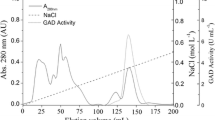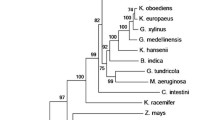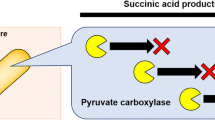Abstract
Pyruvate carboxylase of Corynebacterium glutamicum serves as anaplerotic enzyme when cells are growing on carbohydrates and plays an important role in the industrial production of metabolites derived from the tricarboxylic acid cycle, such as l-glutamate or l-lysine. Previous studies suggested that the enzyme from C. glutamicum is very labile, as activity could only be measured in permeabilized cells, but not in cell-free extracts. In this study, we established conditions allowing activity measurements in cell-free extracts of C. glutamicum and purification of the enzyme by avidin affinity chromatography and gel filtration. Using a coupled enzymatic assay with malate dehydrogenase, Vmax values between 20 and 25 μmol min−1 mg−1 were measured for purified pyruvate carboxylase corresponding to turnover numbers of 160 – 200 s−1 for the tetrameric enzyme. The concentration dependency for pyruvate and ATP followed Michaelis-Menten kinetics with Km values of 3.76 ± 0.72 mM and 0.61 ± 0.13 mM, respectively. For bicarbonate, concentrations ≥5 mM were required to obtain activity and half-maximal rates were found at 13.25 ± 4.88 mM. ADP and aspartate inhibited PCx activity with apparent Ki values of 1.5 mM and 9.3 mM, respectively. Acetyl-CoA had a weak inhibitory effect, but only at low concentrations up to 50 μM. The results presented here enable further detailed biochemical and structural studies of this enzyme.




Similar content being viewed by others
References
Abe S, Takayama K, Kinoshita S (1967) Taxonomical studies on glutamic acid producing bacteria. J Gen Appl Microbiol 13:279–301
Adina-Zada A, Zeczycki TN, Attwood PV (2012) Regulation of the structure and activity of pyruvate carboxylase by acetyl CoA. Arch Biochem Biophys 519(2):118–130. https://doi.org/10.1016/j.abb.2011.11.015
Becker J, Wittmann C (2012) Bio-based production of chemicals, materials and fuels -Corynebacterium glutamicum as versatile cell factory. Curr Opin Biotechnol 23(4):631–640. https://doi.org/10.1016/j.copbio.2011.11.012
Bennett BD, Kimball EH, Gao M, Osterhout R, Van Dien SJ, Rabinowitz JD (2009) Absolute metabolite concentrations and implied enzyme active site occupancy in Escherichia coli. Nat Chem Biol 5(8):593–599
Bertani G (1951) Studies on lysogenesis. I. The mode of phage liberation by lysogenic Escherichia coli. J Bacteriol 62(3):293–300
Bradford MM (1976) A rapid and sensitive method for the quantitation of microgram quantities of protein utilizing the principle of protein-dye binding. Anal Biochem 72:248–254
Chen Z, Bommareddy RR, Frank D, Rappert S, Zeng AP (2014) Deregulation of feedback inhibition of phosphoenolpyruvate carboxylase for improved lysine production in Corynebacterium glutamicum. Appl Environ Microbiol 80(4):1388–1393. https://doi.org/10.1128/aem.03535-13
Cocaign-Bousquet M, Guyonvarch A, Lindley ND (1996) Growth rate-dependent modulation of carbon flux through central metabolism and the kinetic consequences for glucose-limited chemostat cultures of Corynebacterium glutamicum. Appl Environ Microbiol 62(2):429–436
Cocaign-Bousquet M, Lindley ND (1995) Pyruvate overflow and carbon flux within the central metabolic pathways of Corynebacterium glutamicum during growth on lactate. Enzym Microb Technol 17(3):260–267
Eggeling L, Bott M (2015) A giant market and a powerful metabolism: L-lysine provided by Corynebacterium glutamicum. Appl Microbiol Biotechnol 99(8):3387–3394. https://doi.org/10.1007/s00253-015-6508-2
Fairhead M, Howarth M (2015) Site-specific biotinylation of purified proteins using BirA. In: Gautier A, Hinner MJ (eds) Site-specific protein labeling: methods and protocols. Methods in Molecular Biology. Springer Science+Business Media, New York, pp 171–184
Frunzke J, Engels V, Hasenbein S, Gätgens C, Bott M (2008) Co-ordinated regulation of gluconate catabolism and glucose uptake in Corynebacterium glutamicum by two functionally equivalent transcriptional regulators, GntR1 and GntR2. Mol Microbiol 67(2):305–322
Gubler M, Park SM, Jetten M, Stephanopoulos G, Sinskey AJ (1994) Effects of phosphoenol pyruvate carboxylase deficiency on metabolism and lysine production in Corynebacterium glutamicum. Appl Microbiol Biotechnol 40:857–863
Hanahan D (1983) Studies on transformation of Escherichia coli with plasmids. J Mol Biol 166(4):557–580
Jäger W, Peters-Wendisch PG, Kalinowski J, Pühler A (1996) A Corynebacterium glutamicum gene encoding a two-domain protein similar to biotin carboxylases and biotin-carboxyl-carrier proteins. Arch Microbiol 166:76–82
Jetten MSM, Pitoc GA, Follettie MT, Sinskey AJ (1994) Regulation of phospho(enol)-pyruvate and oxaloacetate-converting enzymes in Corynebacterium glutamicum. Appl Microbiol Biotechnol 41(1):47–52
Jitrapakdee S, Adina-Zada A, Besant PG, Surinya KH, Cleland WW, Wallace JC, Attwood PV (2007) Differential regulation of the yeast isozymes of pyruvate carboxylase and the locus of action of acetyl CoA. Int J Biochem Cell Biol 39(6):1211–1223. https://doi.org/10.1016/j.biocel.2007.03.016
Jitrapakdee S, St Maurice M, Rayment I, Cleland WW, Wallace JC, Attwood PV (2008) Structure, mechanism and regulation of pyruvate carboxylase. Biochem J 413(3):369–387. https://doi.org/10.1042/BJ20080709
Keilhauer C, Eggeling L, Sahm H (1993) Isoleucine synthesis in Corynebacterium glutamicum: molecular analysis of the ilvB-ilvN-ilvC operon. J Bacteriol 175(17):5595–5603
Koffas MA, Jung GY, Aon JC, Stephanopoulos G (2002) Effect of pyruvate carboxylase overexpression on the physiology of Corynebacterium glutamicum. Appl Environ Microbiol 68(11):5422–5428
Koffas MA, Ramamoorthi R, Pine WA, Sinskey AJ, Stephanopoulos G (1998) Sequence of the Corynebacterium glutamicum pyruvate carboxylase gene. Appl Microbiol Biotechnol 50(3):346–352
Kortmann M, Mack C, Baumgart M, Bott M (2019) Pyruvate carboxylase variants enabling improved lysine production from glucose identified by biosensor-based high-throughput fluorescence-activated cell sorting screening. ACS Synth Biol 8(2):274–281. https://doi.org/10.1021/acssynbio.8b00510
Laemmli UK (1970) Cleavage of structural proteins during the assembly of the head of bacteriophage T4. Nature 227:680–685
Lai H, Kraszewski JL, Purwantini E, Mukhopadhyay B (2006) Identification of pyruvate carboxylase genes in Pseudomonas aeruginosa PAO1 and development of a P. aeruginosa-based overexpression system for a4- and a4b4-type pyruvate carboxylases. Appl Environ Microbiol 72(12):7785–7792. https://doi.org/10.1128/AEM.01564-06
Lasso G, Yu LP, Gil D, Lazaro M, Tong L, Valle M (2014) Functional conformations for pyruvate carboxylase during catalysis explored by cryoelectron microscopy. Structure 22(6):911–922. https://doi.org/10.1016/j.str.2014.04.011
Milrad de Forchetti SR, Cazzulo JJ (1976) Some properties of the pyruvate carboxylase from Pseudomonas fluorescens. J Gen Microbiol 93(1):75–81. https://doi.org/10.1099/00221287-93-1-75
Molenaar D, van der Rest ME, Drysch A, Yücel R (2000) Functions of the membrane-associated and cytoplasmic malate dehydrogenases in the citric acid cycle of Corynebacterium glutamicum. J Bacteriol 182:6884–6891
Mukhopadhyay B, Patel VJ, Wolfe RS (2000) A stable archaeal pyruvate carboxylase from the hyperthermophile Methanococcus jannaschii. Arch Microbiol 174(6):406–414
Mukhopadhyay B, Purwantini E (2000) Pyruvate carboxylase from Mycobacterium smegmatis: stabilization, rapid purification, molecular and biochemical characterization and regulation of the cellular level. Biochim Biophys Acta 1475:191–206
Mukhopadhyay B, Stoddard SF, Wolfe RS (1998) Purification, regulation, and molecular and biochemical characterization of pyruvate carboxylase from Methanobacterium thermoautotrophicum strain DH. J Biol Chem 273(9):5155–5166
Niebisch A, Kabus A, Schultz C, Weil B, Bott M (2006) Corynebacterial protein kinase G controls 2-oxoglutarate dehydrogenase activity via the phosphorylation status of the OdhI protein. J Biol Chem 281:12300–12307
Ortbauer M, Popp M (2008) Functional role of polyhydroxy compounds on protein structure and thermal stability studied by circular dichroism spectroscopy. Plant Physiol Biochem 46(4):428–434. https://doi.org/10.1016/j.plaphy.2008.02.002
Ozaki H, Shiio I (1969) Regulation of the TCA and glyoxylate cycles in Brevibacterium flavum. II. Regulation of phosphoenolpyruvate carboxylase and pyruvate kinase. J Biochem 66(3):297–311
Peters-Wendisch PG, Eikmanns BJ, Thierbach G, Bachmann B, Sahm H (1993) Phosphoenolpyruvate carboxylase in Corynebacterium glutamicum is dispensable for growth and lysine production. FEMS Microbiol Lett 112(3):269–274
Peters-Wendisch PG, Kreutzer C, Kalinowski J, Patek M, Sahm H, Eikmanns BJ (1998) Pyruvate carboxylase from Corynebacterium glutamicum: characterization, expression and inactivation of the pyc gene. Microbiology 144:915–927
Peters-Wendisch PG, Schiel B, Wendisch VF, Katsoulidis E, Möckel B, Sahm H, Eikmanns BJ (2001) Pyruvate carboxylase is a major bottleneck for glutamate and lysine production by Corynebacterium glutamicum. J Mol Microbiol Biotechnol 3(2):295–300
Peters-Wendisch PG, Wendisch VF, Paul S, Eikmanns BJ, Sahm H (1997) Pyruvate carboxylase as an anaplerotic enzyme in Corynebacterium glutamicum. Microbiology 143(4):1095–1103
Petersen S, de Graaf AA, Eggeling L, Möllney M, Wiechert W, Sahm H (2000) In vivo quantification of parallel and bidirectional fluxes in the anaplerosis of Corynebacterium glutamicum. J Biol Chem 275(46):35932–35941
Purcell AW, Wallace JC (1996) The accessibility of the prosthetic group biotin during monomeric avidin affinity chromatography. Anal Biochem 238(2):213–216. https://doi.org/10.1006/abio.1996.0280
Sauer U, Eikmanns BJ (2005) The PEP-pyruvate-oxaloacetate node as the switch point for carbon flux distribution in bacteria. FEMS Microbiol Rev 29(4):765–794
Schoeffler AJ, Ruiz CR, Joubert AM, Yang X, LiCata VJ (2003) Salt modulates the stability and lipid binding affinity of the adipocyte lipid-binding proteins. J Biol Chem 278(35):33268–33275. https://doi.org/10.1074/jbc.M304955200
Schreiner ME, Fiur D, Holatko J, Patek M, Eikmanns B (2005) E1 enzyme of the pyruvate dehydrogenase complex in Corynebacterium glutamicum: molecular analysis of the gene and phylogenetic aspects. J Bacteriol 187:6005–6018
St Maurice M, Reinhardt L, Surinya KH, Attwood PV, Wallace JC, Cleland WW, Rayment I (2007) Domain architecture of pyruvate carboxylase, a biotin-dependent multifunctional enzyme. Science 317(5841):1076–1079. https://doi.org/10.1126/science.1144504
Tosaka O, Morioka H, Takinami K (1979) Role of biotin-dependent pyruvate-carboxylase in L-lysine production. Agric Biol Chem 43(7):1513–1519. https://doi.org/10.1080/00021369.1979.10863663
Uy D, Delaunay S, Engasser JM, Goergen JL (1999) A method for the determination of pyruvate carboxylase activity during the glutamic acid fermentation with Corynebacterium glutamicum. J Microbiol Methods 39(1):91–96
Wendisch VF, Jorge JMP, Perez-Garcia F, Sgobba E (2016) Updates on industrial production of amino acids using Corynebacterium glutamicum. World J Microbiol Biotechnol 32(6):105. https://doi.org/10.1007/s11274-016-2060-1
Zeczycki TN, Menefee AL, Jitrapakdee S, Wallace JC, Attwood PV, St Maurice M, Cleland WW (2011) Activation and inhibition of pyruvate carboxylase from Rhizobium etli. Biochemistry 50(45):9694–9707. https://doi.org/10.1021/bi201276r
Author information
Authors and Affiliations
Corresponding author
Ethics declarations
Conflict of interest
The authors declare that they have no conflict of interest.
Ethical approval
This article does not contain any studies with human participants or animals performed by any of the authors.
Additional information
Publisher’s note
Springer Nature remains neutral with regard to jurisdictional claims in published maps and institutional affiliations.
Rights and permissions
About this article
Cite this article
Kortmann, M., Baumgart, M. & Bott, M. Pyruvate carboxylase from Corynebacterium glutamicum : purification and characterization . Appl Microbiol Biotechnol 103, 6571–6580 (2019). https://doi.org/10.1007/s00253-019-09982-x
Received:
Revised:
Accepted:
Published:
Issue Date:
DOI: https://doi.org/10.1007/s00253-019-09982-x




